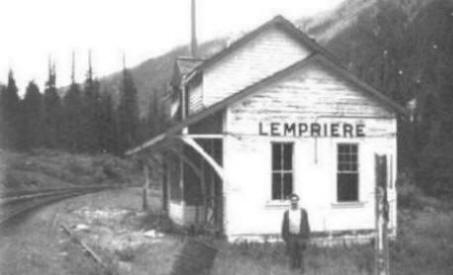Canadian National Railway, SE of Longworth, NW of Guilford
53.8833 N 121.3667 W — Map 93H/14 — Google — GeoHack
Earliest known reference to this name is 1911 (GTP map)
Name officially adopted in 1984
Not currently an official name
Mile 75 in Fraser Subdivision (McBride to Prince George as of 1977)
Grand Trunk Pacific Railway station built in 1914. The Lindup station was moved to Penny in 1947.
Grand Trunk Pacific Railway map [ca. 1912]
Grand Trunk Pacific Railway timetable 1914
Pre-emptor’s map Fort George 1G 1916
Grand Trunk Pacific Railway map ca. 1918
Grand Trunk Pacific Railway map 1919
Grand Trunk Pacific Railway stations
LINDUP: a settlement on the G. T. P. Ry., 5 miles west of Penny, no agent, in Prince George Provincial Electoral District. Has Canadian Express. Charges must be prepaid; tele- graph office.
Population 5. Local resources: Saw mills and mixed farming. Heavily timbered unbroken land about 3 miles distant from the mountains.
Address mail Lindup via Penny or Longworth.
Bochscski M section hand
Hall Harold farming
Jardine Carl section foreman
Jardine Chas farming
Lehman F farming
Persons G homesteader
Segel G lineman G T P— Wrigley 1918
Torsten Berg was the only one to operate a sawmill at Lindup. The mill operated from 1949 to 1952, at which time his timber supply ran out and he moved the mill to Longworth. The timber at Lindup was of nice quality and of good size. Torsten was awarded the contract to supply planks 26 feet long, for the podium for Queen Elizabeth’s coronation in 1952.
The population of Lindup peaked at about 50 people in 1929 and dwindled dramatically the Depression. In 1931 the Prince George Citizen reported that a large relief camp of 100 men were clearing and grubbing road right of way.
Lindup in 2014 does not have any residents and is on a seasonal road that is susceptible to weather restrictions.
— Olson
- Wrigley Directories, Limited. Wrigley’s British Columbia Directory. Vancouver: 1918. Internet Archive
- Olson, Raymond W. Ghost Towns on the East Line. Prince George, B.C.: Raymond W. Olson, 2017
